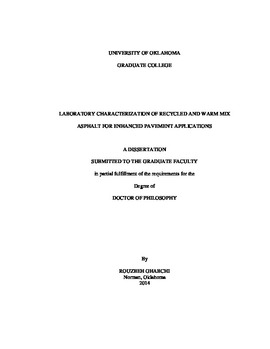| dc.description.abstract | Hot-mix asphalt (HMA) is the most widely used paving material in the U.S. Over the past two decades, many transportation agencies, asphalt producers, and pavement construction companies have taken major initiatives to implement green paving technologies. Saving energy during asphalt production and increased use of reclaimed asphalt materials are important elements of such initiatives. Consequently, there is a need for the characterization of the associated mixes for their performance. Also, implementation of the Mechanistic-Empirical Pavement Design Guide (M-EPDG) requires evaluation of mechanistic input parameters of mixes containing reclaimed materials. The present study addresses two areas of green pavements: characterization of warm mix asphalt (WMA) that uses significantly less energy and produces less emission than HMA, and characterization of HMA containing higher amounts of reclaimed asphalt pavement (RAP) and reclaimed asphalt shingles (RAS) than normally used in Oklahoma. This study also aims to develop important laboratory data that can be used for the local calibration of the M-EPDG for green pavements. A wide range of laboratory tests, namely, dynamic modulus, creep compliance, fatigue, moisture damage, and rutting was conducted to evaluate the performance of the abovementioned mixes and to obtain the M-EPDG input parameters. Another important aspect of this study was to mechanistically evaluate the effect of using different types and amounts of WMA additives, RAP, and RAS on the moisture-induced damage potential, a common problem for flexible pavements, using the surface free energy (SFE) approach. It was found that the WMA mixes have lower dynamic modulus (lower stiffness), reduced potential of low temperature cracking, lower fatigue life, and a higher rutting potential compared to their HMA counterparts. For mixes containing RAP and/or RAS, it was found that dynamic modulus and creep compliance increase and decrease, respectively, with an increase in the amount of RAP and/or RAS used in the mix. The fatigue life was found to increase with increasing RAP content up to 25%, and to decrease when the RAP and/or RAS content exceeds 25%. The Hamburg wheel tracking (HWT) tests showed increased resistance to rutting and moisture-induced damage, with an increase in the amount of RAP and/or RAS. The SFE study on WMA additives revealed that Sasobit® and Advera® are able to reduce the moisture susceptibility of the WMA, but are not recommended to be used with granite. Evotherm® resulted in the highest increase in wettability, total surface free energy, increased work of adhesion and reduced work of debonding, resulting in a better possible aggregate coating with asphalt binder and lower moisture susceptibility with all types of aggregates, compared to those of other WMA-additives. Furthermore, SFE tests conducted on aggregates and asphalt binder blends with RAP binder indicated that the resistance to moisture-induced damage increased with an increase in RAP content of the tested asphalt binders (PG 64-22 and PG 76-28) and all types of aggregates, specifically at higher RAP contents. Furthermore, a new composite energy ratio parameter, based on the job-mix formula and SFE parameters was proposed and shown to be capable of evaluating the moisture-induced damage potential of the tested asphalt mixes containing RAP. The findings of this study are expected to be useful in understanding the effects of using different WMA technologies, RAP, and RAS on the performance of asphalt mixes, and the moisture-induced damage mechanism. Important design input parameters, developed in this study, may be used for the local calibration of M-EPDG, for new asphalt mixes. | en_US |
